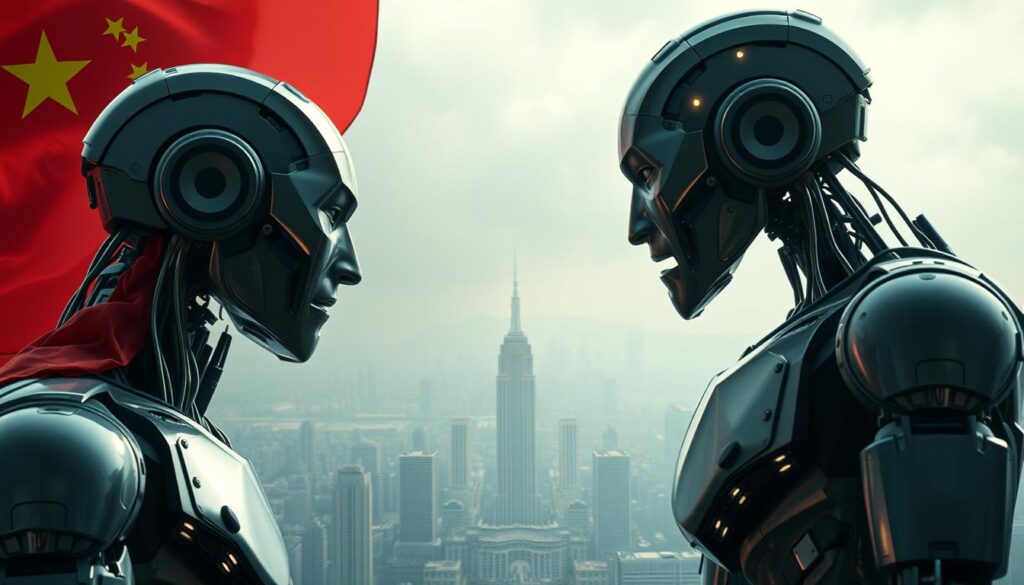“The future belongs to those who prepare for it today,” said Malcolm X, a sentiment that resonates deeply with China’s approach to artificial intelligence. As the global race for technological dominance intensifies, China has positioned itself as a formidable player, driven by ambitious policies and significant investments. The country’s focus on self-reliance and innovation has set it apart in the field of artificial intelligence, making it a key competitor to the United States.
China’s strategy is anchored in high-level initiatives like the Artificial Intelligence Development Plan (AIDP) and the Made in China 2025 program. These frameworks emphasize the importance of mastering core technologies and fostering domestic innovation. The Chinese government has also allocated substantial resources, with investments totaling $184 billion in the AI sector between 2000 and 20231. This commitment underscores the nation’s determination to lead in artificial intelligence.
Moreover, China’s efforts extend beyond financial support. The government has introduced policies to encourage the adoption of domestic AI products, such as subsidies for firms purchasing locally produced AI chips1. This approach not only strengthens the domestic market but also reduces reliance on foreign technology. As China continues to bridge the gap with the United States, its unique strategy offers valuable insights into the future of global technology leadership.
Key Takeaways
- China’s AI strategy is driven by self-reliance and innovation.
- High-level policies like AIDP and Made in China 2025 shape its approach.
- Significant government investments support AI development.
- Subsidies encourage the use of domestic AI products.
- China aims to reduce reliance on foreign technology.
- The strategy positions China as a key competitor to the United States.
Overview of China’s Ambitious AI Landscape

China’s journey in artificial intelligence began with a clear vision to dominate the global tech landscape. Early government strategies laid the groundwork for what would become a thriving industry. Key milestones, such as the Made in China 2025 initiative and the Artificial Intelligence Development Plan, highlight the nation’s commitment to innovation and self-reliance.
By the first quarter of 2024, China hosted over 4,500 AI companies, representing 15% of the global total2. This growth reflects the government’s focus on fostering a robust ecosystem. The added value of the core AI industry reached RMB 508 billion (US$75 billion) in 2022, marking an 18% year-on-year increase2.
Historical Foundations and Policy Milestones
The Made in China 2025 plan, launched in 2015, aimed to reduce reliance on foreign technology and boost domestic innovation. This was followed by the Artificial Intelligence Development Plan in 2017, which set ambitious goals for AI research and applications. These policies have driven significant investments and collaborations across industries.
For example, Beijing’s Zhongguancun Science Park has become a hub for AI startups and research institutions2. Similarly, Shanghai’s AI industry is projected to grow to US$55.11 billion by 2025, with an annual growth rate of over 12%2. These efforts underscore the strategic shift triggered by government directives and industry investments.
Current Global Standing
China’s AI industry is now a major player on the global stage. The country accounted for 26% of the world’s total computing power as of June 20243. Additionally, 47% of the world’s top AI researchers are based in China3, highlighting its growing influence in the field.
Despite being six to twenty-four months behind the United States in AI model development4, China’s aggressive policies and investments are narrowing the gap. The nation’s focus on self-reliance and innovation continues to shape its competitive edge in the global AI race.
Foundational Initiatives Shaping Chinese AI

China’s rise in the global tech arena is rooted in its early foundational initiatives. Two key programs, the Artificial Intelligence Development Plan (AIDP) and Made in China 2025, laid the groundwork for its technological dominance. These initiatives emphasized self-reliance, innovation, and strategic investments in critical sectors.
The AIDP, launched in 2017, set ambitious goals for advancing research and applications. It aimed to make China a global leader in artificial intelligence by 2030. The government allocated significant resources, with investments exceeding $184 billion between 2000 and 20235. This funding supported advancements in machine learning, natural language processing, and robotics.
Similarly, the Made in China 2025 initiative focused on reducing reliance on foreign technology. It prioritized the development of domestic industries, including semiconductors and AI hardware. By fostering collaboration between public research labs, military, and private companies, the program accelerated innovation across sectors2.
Research and Development Efforts
These initiatives spurred extensive research and development efforts. China’s AI industry achieved an annual growth rate of over 10% from 2018 to 20222. The added value of the core AI industry reached RMB 508 billion (US$75 billion) in 2022, marking an 18% year-on-year increase2.
Cross-sector collaboration was a cornerstone of these programs. For example, Beijing’s Zhongguancun Science Park became a hub for AI startups and research institutions5. Shanghai’s AI industry is projected to grow to US$55.11 billion by 2025, with an annual growth rate of over 12%2.
Strategic Objectives and Lasting Impact
The government’s focus on embedding artificial intelligence into national defense and economic strategies has been transformative. These initiatives integrated broader policy reforms, creating a robust ecosystem for innovation. By 2024, China hosted over 4,500 AI companies, representing 15% of the global total2.
These foundational programs have set the stage for China’s continued leadership in technology. Their lasting impact is evident in the nation’s progress toward self-reliance and its growing influence in the global AI landscape.
| Initiative | Key Objectives | Impact |
|---|---|---|
| AIDP | Advance research, achieve global leadership by 2030 | Significant investments, advancements in AI technologies |
| Made in China 2025 | Reduce reliance on foreign technology, boost domestic industries | Cross-sector collaboration, accelerated innovation |
What Makes China’s AI Strategy Unique?

China’s approach to artificial intelligence stands out due to its dual focus on industrial and defense applications. This multifaceted strategy has positioned the nation as a global leader in both commercial and national security domains. By integrating AI into diverse sectors, China has created a robust ecosystem that drives innovation and competitiveness on the world stage6.
One of the most notable applications is in surveillance. Advanced systems powered by AI are widely used for public safety and monitoring. These technologies not only enhance security but also provide valuable data for urban planning and resource management7.
In the defense sector, autonomous weaponry and military systems are rapidly evolving. China’s investments in AI-driven defense technologies aim to enhance strategic capabilities and reduce human intervention in critical operations8. This integration of AI into national security reflects a broader trend of coupling technological advancement with defense priorities.
Industrial automation is another key area. AI-powered robotics and smart manufacturing systems are transforming production processes. By 2024, over 50% of China’s manufacturing sectors are expected to deploy AI technologies7. This shift not only boosts efficiency but also strengthens the nation’s position in global supply chains.
The strategic rationale behind these applications is clear. By embedding AI into both commercial and defense platforms, China ensures a balanced approach to technological development. This dual focus allows for rapid deployment and scalability across various domains6.
China’s unique integration of AI into multiple sectors signals a shift in both technological and geopolitical paradigms. The scale and diversity of initiatives underscore the nation’s ambition to lead on the world stage. These efforts highlight the operational model that enables fast and effective implementation of AI solutions8.
| Application | Key Features | Impact |
|---|---|---|
| Surveillance | AI-driven monitoring, data analysis | Enhanced public safety, urban planning |
| Military Autonomy | Autonomous weaponry, strategic systems | Improved defense capabilities |
| Industrial Automation | Robotics, smart manufacturing | Increased efficiency, global competitiveness |
In summary, China’s AI strategy is defined by its dual application in industrial and defense sectors. This approach not only drives innovation but also positions the nation as a key player in the global technology landscape. The integration of AI into diverse domains underscores China’s commitment to shaping the future of artificial intelligence6.
Evolution of Chinese AI Policy and Governance

The interplay between diplomacy and military modernization has been pivotal in shaping China’s AI governance framework. Over the years, the country’s approach has evolved to address both domestic priorities and global challenges. This evolution reflects a strategic balance between innovation, security, and international cooperation.
Diplomatic channels have played a significant role in shaping governance models. For example, remarks by Fu Ying, a prominent Chinese diplomat, highlighted the importance of international collaboration in AI development. Similarly, Major General Ding Xiangrong emphasized the need for integrating AI into national defense strategies9. These discussions have influenced policy adjustments, particularly in response to global concerns about AI arms races.
Military requirements have also driven governance frameworks. The “New Generation Artificial Intelligence Development Plan” (2017) set ambitious goals, positioning AI as a “major strategic opportunity” for both economic and defense sectors10. This plan underscored the importance of intelligence and security in government decision-making, ensuring that AI advancements align with national defense priorities.
Policy Adjustments and Strategic Shifts
Real-world examples of policy adjustments include the “Measures for Generative AI Services” (2023), which regulate AI applications and ensure ethical standards10. These measures reflect lessons learned from early military engagements and diplomatic forums, balancing innovation with risk management.
The rapid pace of technological change has challenged the steady evolution of policy. For instance, the “Artificial Intelligence Law of the People’s Republic of China” (Draft, 2024) aims to regulate AI products while promoting innovation10. This draft highlights the government’s focus on information control and economic growth, ensuring that AI development aligns with broader strategic goals.
Lessons from Governance Evolution
China’s governance evolution offers valuable insights into balancing innovation with security. The “Trustworthy AI” White Paper (2021) categorizes governance actors into corporate, industry, government, and technology research sectors10. This framework ensures accountability and fosters collaboration across sectors.
In summary, China’s AI governance has been shaped by diplomatic exchanges, military modernization, and strategic policy adjustments. This evolution underscores the country’s commitment to leading in artificial intelligence while addressing global and domestic challenges.
| Policy Document | Key Focus | Impact |
|---|---|---|
| New Generation AI Development Plan (2017) | Economic and defense integration | Set ambitious goals for AI leadership |
| Measures for Generative AI Services (2023) | Ethical standards and regulation | Ensured responsible AI applications |
| Artificial Intelligence Law (Draft, 2024) | Regulation and innovation | Balanced information control with growth |
Integrating AI into National Security and Military Modernization

China’s advancements in military technology are reshaping global security dynamics, with artificial intelligence at the forefront. The nation’s focus on integrating AI into defense systems highlights its commitment to maintaining a strategic edge in modern warfare. This approach is driven by a vision of “intelligentized warfare,” where AI enhances decision-making, precision, and operational efficiency11.
Use in Autonomous Weaponry and Surveillance
Autonomous weaponry, such as armed drones, is a key area of progress. These systems leverage AI for target detection, missile guidance, and electronic warfare, reducing the need for human intervention12. For example, China’s multi-domain precision warfare integrates AI and big data to identify vulnerabilities in enemy systems, ensuring precise targeting12.
Surveillance tools, particularly in regions like Xinjiang, demonstrate the dual-use nature of AI technologies. Advanced systems analyze vast amounts of data for public safety and resource management, while also supporting military objectives12.
Security Implications and Arms Control Considerations
The rapid development of military AI raises significant security concerns. The absence of a global governance framework for these technologies poses risks to international peace and security11. As China invests in AI-enabled systems, the potential for an arms race grows, challenging existing arms control mechanisms11.
Export controls on advanced semiconductors, crucial for high-end AI applications, are impacting China’s military ambitions12. However, the nation’s centralized decision-making processes may limit its ability to fully utilize AI-enabled systems12.
“AI is the most powerful weapon of our time,” said Jen Easterly, Director of the U.S. Cybersecurity and Infrastructure Security Agency11.
China’s leadership in military AI reflects its broader strategic aims. By embedding AI into defense and civilian sectors, the nation is advancing its technological capabilities while addressing global security challenges12.
| Application | Key Features | Impact |
|---|---|---|
| Autonomous Weaponry | Target detection, missile guidance | Enhanced precision, reduced human intervention |
| Surveillance | Data analysis, public safety | Dual-use for military and civilian purposes |
| Arms Control | Export restrictions, governance challenges | International security risks |
In summary, China’s integration of AI into national security and military modernization underscores its leadership in technological progress. This strategy not only strengthens its defense capabilities but also highlights the need for global cooperation in addressing the challenges posed by military AI11.
Developing a Robust AI Ecosystem in China

A thriving ecosystem of startups, research institutions, and government support has propelled China’s technological rise. This self-sustaining environment fosters rapid adoption and integration of innovations, positioning the country as a global leader in technology3.
The building blocks of this ecosystem include over 4,300 companies, with the AI industry projected to exceed $140 billion by 20303. Public institutions and private firms collaborate to nurture innovation, ensuring a steady flow of research and development. For example, Baidu’s generative AI contributed 656 million renminbi to its 2023 revenue, showcasing the commercial potential of this ecosystem13.
Government initiatives have been instrumental in this growth. The Cyberspace Administration of China has approved more than 40 large language models in the past six months, reflecting a commitment to fostering innovation13. Additionally, state-led programs encourage the adoption of domestic technologies, reducing reliance on foreign solutions.
Startups emerging from academic incubators are a testament to the ecosystem’s success. Alibaba’s Qwen model, used by 90,000 enterprises, highlights how academic research translates into real-world applications13. This seamless integration of research and industry accelerates technological diffusion.
“Innovation thrives when research, industry, and policy align,” said a leading Chinese tech analyst.
Regulatory frameworks also play a crucial role. By setting standards and promoting ethical practices, the government ensures sustainable growth. For instance, China’s AI standards framework aims to impact 1,000 technology companies by 20263.
In summary, China’s ecosystem is a model of self-reliance and innovation. It combines public support, private enterprise, and academic research to drive technological advancements. This approach not only strengthens national competitiveness but also enhances global influence.
Financial Support and Government-Backed Investment in AI

Government-backed investments have played a pivotal role in shaping China’s AI landscape. Over the past decade, China’s government VC funds have invested a total of $912 billion, with 23% directed to 1.4 million AI-related firms14. This financial commitment underscores the nation’s focus on fostering innovation and building a robust ecosystem.
Government Guidance Funds and Subsidies
Government guidance funds are a cornerstone of China’s AI strategy. These funds provide critical support to early-stage and high-potential firms, bridging gaps where private capital may fall short. From 2013 to 2018, an average of 238 government VC funds were created annually, though this number has since slowed to 115 per year14.
Subsidies further encourage the adoption of domestic AI products. For example, firms receiving government funding achieved a 500% growth in software production by 202314. Such initiatives not only boost innovation but also enhance the capability of local companies to compete globally.
Regional Investment and State-Directed Capital
Regional investments are another key driver of AI development. Beijing and Shanghai have emerged as hubs for innovation, with state-directed capital fueling growth. Government VC funds are more evenly distributed across provinces, while private VC funds concentrate in wealthier coastal regions14.
For instance, 4,115 AI firms received investments from both government and private VCs between 2000 and 2023, accounting for 52% of government VC portfolios14. This collaboration ensures a balanced approach to funding, supporting firms in both developed and less affluent areas.
“Strategic investments in AI are essential for maintaining technological leadership,” said a leading Chinese policymaker.
The impact of these investments extends beyond financial support. They play a crucial role in training talent and building capability within the AI sector. By 2030, China’s AI investments are projected to contribute an additional $7 trillion to its GDP15.
In summary, government-backed financial instruments and regional investments are fueling AI innovation in China. These efforts reflect the strategic intent of policymakers to scale AI solutions and enhance global competitiveness.
Chinese Leadership in AI Research, Patents, and Talent

China’s academic institutions and startups are driving groundbreaking advancements in artificial intelligence, solidifying the nation’s position as a global leader in innovation. Universities like Tsinghua University have played a pivotal role in shaping the science technology landscape, producing cutting-edge research and fostering talent16.
Over the past year, China has emerged as a global leader in AI patents, with Tsinghua University contributing significantly to this growth. The university’s research labs have developed technologies ranging from natural language processing to autonomous systems, many of which have been patented and commercialized17.
Academic Contributions and Start-Up Innovation
Academic institutions are not the only drivers of innovation. A wave of successful startups has complemented their efforts, creating a dynamic ecosystem. For example, startups emerging from Tsinghua’s incubators have developed AI solutions for industries like healthcare and finance, showcasing the practical applications of academic research16.
Government and industry collaborations have further strengthened this ecosystem. Programs that encourage control over technology development have ensured that innovations align with national priorities. This synergy between academia, startups, and policymakers has accelerated China’s progress in AI17.
- Tsinghua University leads in AI research and patent development.
- Startups are transforming academic breakthroughs into real-world solutions.
- Government-industry collaborations foster innovation and control over technology.
Yearly trends show sustained growth in research output and patent filings. For instance, China filed over 70% of the world’s AI patents in the last year, highlighting its dominance in the field16. This trend is expected to continue as more resources are allocated to science technology initiatives.
Case studies of research breakthroughs, such as AI-powered diagnostic tools and autonomous robotics, demonstrate the tangible impact of these efforts. These innovations not only enhance China’s technological capabilities but also contribute to global advancements in AI17.
In summary, China’s leadership in AI research and patents is a testament to the collaborative efforts of academic institutions, startups, and the government. This approach ensures control over technology development and positions China as a key player in the global AI race. For more insights into AI innovations, explore AI in Finance.
Comparative Analysis: China versus United States in AI

The race for global AI dominance is intensifying, with China and the United States leading the charge. Both nations have adopted distinct strategies, shaping the future of artificial intelligence through investments, research, and commercialization. This comparative analysis explores their funding landscapes, research outputs, and service delivery models, highlighting how each approach influences the global AI market.
Investment Dynamics
Investment in AI is a cornerstone of both nations’ strategies. The U.S. led global R&D spending in 2019 with $656 billion, while China followed closely with $526 billion18. In 2020, 82% of global AI venture capital funding went to the U.S. ($27.6 billion) and China ($16.9 billion)18. These investments reflect their commitment to innovation and technological leadership.
China’s government-backed funds have supported over 1.4 million AI-related firms, with 23% of $912 billion directed to AI18. In contrast, the U.S. relies more on private venture capital, fostering a competitive startup ecosystem. This difference in funding approach shapes their respective AI landscapes.
Research Output and Collaboration
Research output is another key metric. The U.S. produced 1,365,452 AI papers (25.23% of global output), while China contributed 957,840 papers (17.70%)18. Despite China’s lower output, its collaboration with the U.S. has yielded high-impact research. Over 47,715 co-authored articles demonstrate the synergy between the two nations19.
China’s focus on information technology development has accelerated its research capabilities. For instance, Baidu’s Ernie 4.5 showcases advanced multimodal understanding, while Tencent’s Hunyuan 3D-2.0 transforms text and images into 3D models19. These innovations highlight China’s growing influence in AI research.
Commercialization and Service Delivery
Commercialization pathways differ significantly. The U.S. excels in integrating AI into diverse sectors, from healthcare to finance. For example, OpenAI’s GPT-4.5 and DeepMind’s Perceiver are designed for high-performance tasks19. This approach ensures rapid adoption and scalability.
China, on the other hand, emphasizes domestic service delivery. Government subsidies encourage the use of locally produced AI products, reducing reliance on foreign technology. This strategy strengthens the domestic market while fostering innovation. For more insights into AI innovations, explore AI Tools.
| Metric | United States | China |
|---|---|---|
| R&D Spending (2019) | $656 billion | $526 billion |
| AI Papers Produced | 1,365,452 | 957,840 |
| Venture Capital (2020) | $27.6 billion | $16.9 billion |
| Global AI Impact | 43.9% of hits | 10.9% of hits |
In summary, the U.S. and China are shaping the global AI landscape through distinct strategies. While the U.S. leverages private investments and diverse applications, China focuses on government-backed funding and domestic service delivery. These differences highlight the competitive dynamics driving AI innovation worldwide.
International Security Implications of Chinese AI Developments

The rapid advancements in Chinese artificial intelligence have sparked significant international security concerns. As autonomous weapon systems and surveillance technologies become more sophisticated, global stability faces new challenges. These developments are not just a priority for China but also a critical issue for the international community20.
Autonomous weapon systems, such as those developed by DeepSeek, demonstrate capabilities rivaling top U.S. models at a fraction of the cost20. This raises questions about the potential for new arms races. The use of such technologies in military strategies could lower the threshold for military action, increasing the risk of conflict21.
Surveillance technologies, particularly in regions like Xinjiang, highlight the dual use of AI. While these systems enhance public safety, they also pose risks to global stability by enabling mass monitoring and control20. This has led to debates on how to regulate such technologies internationally.
Chinese white papers and diplomatic statements emphasize the priority of integrating AI into national defense. For example, the “Artificial Intelligence Safety Commitments” signed by sixteen Chinese companies aim to align AI development with national security goals22. These efforts, however, have raised concerns about the lack of a global governance framework for AI arms control21.
“AI is the most powerful weapon of our time,” said Jen Easterly, Director of the U.S. Cybersecurity and Infrastructure Security Agency21.
Historically, arms control measures like the U.S.-Soviet cooperation on permissive action links (PALs) have set precedents for managing new technologies21. However, the lack of prior engagement between the U.S. and China on AI safety poses a barrier to similar cooperation today21.
These developments also affect international alliances and policymaking. For instance, the U.S. AI Safety Institute (AISI) is working to create a global network for AI safety best practices21. Meanwhile, China’s focus on self-reliance in AI technology complicates efforts for international collaboration20.
Proposals for cooperative arms control measures are gaining traction. The Frontier AI Safety Commitments (FAISCs) announced at the AI Summit aim to establish best practices to prevent catastrophic risks22. However, only one Chinese frontier AI company, Zhipu.ai, has signed onto these commitments, limiting their effectiveness22.
In summary, the geopolitical stakes of Chinese AI advancements are high. The international community must use policy and diplomacy to manage these risks effectively. For more insights into AI safety, explore ChatGPT.
Domestic and Export Applications of AI Technology

China’s technological advancements in artificial intelligence are reshaping both domestic industries and global markets. The nation has successfully integrated AI into various sectors, from surveillance to robotics, while also exporting cutting-edge technologies worldwide. This dual-use approach highlights China’s ability to leverage innovation for both internal growth and international influence.
Surveillance, Robotics, and Autonomous Systems
Domestically, AI plays a critical role in surveillance and robotics. Advanced facial recognition systems, like those deployed in Xinjiang, are used for public safety and resource management23. These technologies not only enhance security but also contribute to urban planning and economy efficiency.
In the industrial sector, AI-powered robotics are transforming manufacturing processes. By 2024, over 50% of China’s manufacturing sectors are expected to deploy AI technologies24. This shift boosts productivity and strengthens the nation’s position in global supply chains.
China’s export strategies are equally impressive. Autonomous systems, such as drones, are being exported to countries in the Middle East, showcasing China’s ability to deploy advanced technologies internationally23. These exports not only generate revenue but also enhance China’s global influence.
Impact on Economy and National Security
The integration of AI into both domestic and export applications has significant economic and security implications. Domestically, AI-driven innovations contribute to the economy by improving efficiency and creating new industries. For example, the Chinese government has introduced subsidies for firms purchasing domestically produced AI chips, boosting the semiconductor industry1.
On the international stage, AI exports enhance China’s strategic capabilities. Technologies like autonomous drones and surveillance systems are not only commercial products but also tools for geopolitical influence23. This dual-use nature underscores the importance of state support for technological innovation.
| Application | Domestic Use | Export Impact |
|---|---|---|
| Surveillance | Public safety, urban planning | Geopolitical influence |
| Robotics | Industrial automation | Global supply chain integration |
| Autonomous Systems | Defense and security | Revenue generation, strategic partnerships |
In conclusion, China’s AI applications demonstrate a balance between domestic innovation and international export strategies. This approach not only strengthens the nation’s economy but also positions it as a global leader in technology. Continued state support will be crucial for maintaining this dual advantage in the future.
Understanding Barriers: Compute, Data, and Export Controls

The global race for technological supremacy has placed significant barriers in China’s path to AI dominance. Technical and regulatory challenges, particularly in advanced semiconductors and export controls, are reshaping the nation’s effort to lead in artificial intelligence. These constraints not only slow progress but also impact market competitiveness on a global scale.
Impact of Advanced Node Semiconductor Restrictions
U.S. export controls on advanced compute and semiconductor manufacturing equipment have created substantial hurdles. For instance, DeepSeek, a leading Chinese AI firm, reportedly requires 2 to 4 times the computing power to achieve results comparable to those using advanced chips like the H10025. This inefficiency increases costs and delays innovation, highlighting the importance of overcoming these barriers.
By early 2024, large-scale H100 chip smuggling operations were reported, with transactions worth over $100 million25. Such activities underscore the lengths to which Chinese firms are going to bypass restrictions. However, these measures are unsustainable and highlight the need for long-term solutions.
Economic and Strategic Implications
The economic impact of these restrictions is significant. DeepSeek’s capital expenditures on GPU servers alone are estimated at $1.63 billion, excluding other data center costs25. This financial burden limits resources for other critical areas of development. Over the next decade, addressing these challenges will be crucial for maintaining competitiveness.
Government and industry initiatives are already underway to mitigate these issues. For example, Huawei’s Ascend 910B chip offers a 1.2 times improvement over its predecessor, though it still lags behind industry leaders26. Such efforts demonstrate the effort to reduce reliance on foreign technology.
Strategies for Overcoming Barriers
To address these challenges, China is focusing on indigenous innovation and supply chain resilience. The government is investing in domestic semiconductor manufacturing and fostering collaboration between research institutions and private firms. These initiatives aim to reduce dependence on foreign technology and strengthen the nation’s capability to compete globally.
“The ongoing efficiency gains in AI development follow predictable industry trends, making capabilities increasingly accessible,” noted a recent industry report26.
In conclusion, while technical and regulatory barriers pose significant challenges, China’s effort to overcome them highlights the importance of innovation and self-reliance. Over the next decade, strategic investments and policy adjustments will be critical for maintaining a competitive edge in the global AI landscape.
Self-Reliance and the Push for Indigenous AI Solutions

China’s push for self-reliance in technology has become a cornerstone of its national strategy, particularly in the field of artificial intelligence. This drive is fueled by the need to reduce dependency on foreign technologies and strengthen domestic innovation. President Xi Jinping has emphasized the importance of building a self-sufficient technological ecosystem, stating that China aims to become a global leader in science and technology by 20354.
To achieve this goal, the Chinese government has implemented a series of policy measures and regulatory frameworks. For instance, the Artificial Intelligence Development Plan (2017) set ambitious targets for advancing indigenous innovation. These policies have encouraged investments in domestic research and development, fostering a competitive local ecosystem27.
One notable success is the deployment of nearly 300,000 industrial robots in China, significantly outpacing other nations like Japan and the United States4. This achievement highlights the effectiveness of government initiatives in promoting homegrown technologies. Additionally, the Cyberspace Administration of China has approved over 180 large language models for general use, further showcasing the nation’s progress in indigenous innovation4.
The link between self-reliance and national security is undeniable. By reducing reliance on foreign components, China enhances its strategic autonomy and resilience. This is particularly evident in the defense sector, where AI-driven autonomous systems are being developed to bolster military capabilities27.
However, balancing open innovation with rigorous regulation remains a challenge. While policies like the Measures for Generative AI Services (2023) ensure ethical standards, they also risk stifling creativity. Despite these hurdles, China’s commitment to self-reliance continues to shape its technological landscape27.
| Initiative | Objective | Impact |
|---|---|---|
| Artificial Intelligence Development Plan | Advance indigenous innovation | Increased R&D investments, homegrown technologies |
| Measures for Generative AI Services | Ensure ethical standards | Balanced innovation with regulation |
| Cyberspace Administration Approvals | Promote large language models | Enhanced domestic AI capabilities |
In conclusion, China’s focus on self-reliance in artificial intelligence is reshaping its technological future. By fostering indigenous innovation and addressing regulatory challenges, the nation is positioning itself as a global leader in science and technology. This strategic shift will undoubtedly influence global technology trends in the years to come.
Future Trends in Industrial AI: Manufacturing, Robotics, and Biotechnology
The industrial sector is undergoing a transformative shift, driven by advancements in artificial intelligence and automation. These technologies are not only enhancing efficiency but also creating new opportunities for innovation across manufacturing, robotics, and biotechnology.
Industrial Leapfrog Opportunities
Traditional manufacturing processes are being revolutionized by advanced models that enable leapfrogging. For instance, Alibaba’s large language models (LLMs) are being integrated into production lines to optimize workflows and reduce costs28. This approach allows companies to bypass outdated methods and adopt cutting-edge solutions directly.
Data-driven insights are also playing a crucial role. By analyzing performance datum, manufacturers can identify inefficiencies and implement targeted improvements. This has led to a 14% increase in productivity in some sectors29.
Robotics and Automation Innovations
Robotics is at the forefront of industrial innovation. Autonomous systems powered by advanced algorithms are transforming production lines. These systems can perform complex tasks with minimal human intervention, significantly boosting efficiency30.
For example, Chinese manufacturers have deployed over 300,000 industrial robots, outpacing other nations28. This trend is expected to continue, with 50% of manufacturing sectors adopting AI technologies by 202428.
Interdisciplinary efforts in biotechnology are also creating new business models. AI-driven solutions are being used to optimize drug discovery and enhance agricultural productivity. These innovations highlight the potential of combining datum from diverse fields to drive progress29.
| Trend | Impact | Example |
|---|---|---|
| Manufacturing Leapfrogging | Cost reduction, efficiency gains | Alibaba’s LLMs in production lines |
| Robotics Automation | Increased productivity, reduced labor costs | 300,000 industrial robots deployed |
| Biotech Applications | Optimized drug discovery, agricultural innovation | AI-driven biotech solutions |
In conclusion, the integration of advanced models, datum, and algorithms is reshaping the industrial landscape. These trends not only enhance efficiency but also position China as a leader in future industrial technologies. The ongoing innovations in manufacturing, robotics, and biotechnology underscore the transformative potential of industrial AI.
Policy Recommendations for U.S. Policymakers
To maintain its competitive edge in artificial intelligence, the United States must adopt strategic policies that foster innovation and address emerging challenges. The rapid advancements in China’s technology sector highlight the need for coordinated efforts to sustain U.S. leadership in the global market.
Stimulating Private Investment and Federal Support
One critical step is to boost private sector investment in AI research and development. Policymakers should consider tax incentives and grants to encourage firms to invest in cutting-edge technologies. Expanding federal funding for AI initiatives, such as those under the CHIPS and Science Act, is equally essential to accelerate advancements31.
For example, the U.S. has already made significant changes to export controls, restricting China’s access to advanced semiconductor technologies32. These measures can be complemented by increasing domestic production capabilities, ensuring that the U.S. remains a leader in AI hardware and software.
Enhancing Data Strategies and Workforce Training
Improving data infrastructure is another priority. Policymakers should focus on creating secure, scalable data systems that support AI development. Streamlining data access and sharing protocols can drive innovation across industries, from healthcare to transportation31.
Investing in workforce training is equally crucial. Expanding STEM education programs and offering reskilling opportunities will ensure a steady pipeline of talent capable of sustaining AI leadership. For instance, the U.S. risks losing its competitive edge if it fails to address workforce gaps while China continues to dominate emerging markets31.
“Strategic investments in AI are essential for maintaining technological leadership,” said a leading U.S. policymaker.
| Policy Area | Recommendation | Impact |
|---|---|---|
| Private Investment | Tax incentives, grants for R&D | Encourages innovation, boosts competitiveness |
| Federal Support | Expand funding under CHIPS Act | Accelerates AI advancements |
| Data Infrastructure | Secure, scalable data systems | Drives cross-industry innovation |
| Workforce Training | Expand STEM education, reskilling | Ensures talent pipeline, sustains leadership |
In conclusion, addressing these areas will help the U.S. maintain its leadership in artificial intelligence. By fostering collaboration between government, research institutions, and the private sector, policymakers can create a robust ecosystem that drives innovation and ensures long-term competitiveness. For more insights into AI strategies, explore China’s AI Strategy.
Conclusion
China’s technological advancements have reshaped the global landscape, driven by a mix of policy, military, and industrial applications. Over the past five years, venture capital funding in the sector reached $120 billion, reflecting the nation’s commitment to innovation33. This investment has fueled significant progress, with China surpassing the U.S. in patents and research output, publishing 33.2% of advanced analytics papers compared to the U.S.’s 13%33.
The integration of artificial intelligence into defense and manufacturing highlights China’s dual-use approach. Initiatives like Lighthouse Factories have reduced energy consumption by 24% and waste by 50%, showcasing the practical benefits of these technologies33. Meanwhile, the U.S. and China are expected to begin talks on AI safety in 2024, reflecting the growing importance of international collaboration34.
As global competition intensifies, careful policy and investment decisions will shape the future of technology leadership. For stakeholders, understanding these dynamics is crucial. Explore more on how to leverage these trends in the AI investment landscape.
FAQ
What are the key historical milestones in China’s AI development?
How does China’s AI strategy compare to the United States?
What role does AI play in China’s national security?
How is China building its AI ecosystem?
What are the challenges China faces in AI development?
How does China integrate AI into its industrial sectors?
What are the international implications of China’s AI advancements?
What policy recommendations are suggested for U.S. policymakers?
Source Links
- How Innovative Is China in AI?
- Exploring China’s Leading AI Hubs: A Regional Analysis
- Assessing China’s AI development and forecasting its future tech priorities
- In Developing AI, China Takes the Industrial Route
- China And AI In 2025: What Global Executives Must Know To Stay Ahead
- China’s AI development model in an era of technological deglobalization
- Understanding the PRC Grand Strategy AI Model: China’s Strategic Vision Decoded
- China’s AI Policy & Development: What You Need to Know
- An Analysis of China’s AI Governance Proposals | Center for Security and Emerging Technology
- Governing Military AI Amid a Geopolitical Minefield
- China Bets Big on Military AI
- China’s Generative AI Ecosystem in 2024: Rising Investment and Expectations
- Government Venture Capital and AI Development in China
- Greater China Insights—China’s AI Growth Multiplier
- The AI Superpower Showdown
- China Is Rapidly Becoming a Leading Innovator in Advanced Industries
- China and the U.S. produce more impactful AI research when collaborating together – Scientific Reports
- The AI Superpower Rivalry: A Zero-sum Game Between China and the United States?
- The Real Threat of Chinese AI
- How Might the United States Engage with China on AI Security Without Diffusing Technology?
- DeepSeek and Other Chinese Firms Converge with Western Companies on AI Promises
- Strategic Reorientation on AI Competition with China
- DeepSeek: How China’s ‘AI heroes’ overcame US curbs to stun Silicon Valley
- DeepSeek, Huawei, Export Controls, and the Future of the U.S.-China AI Race
- DeepSeek’s Lesson: America Needs Smarter Export Controls
- China leans into using AI − even as the US leads in developing it
- China’s AI Revolution: The Global Tech Power Shift – The Geopolitics
- Accelerating the Future: Industrial Strategy in the Era of AI
- America’s AI Strategy: Playing Defense While China Plays to Win
- Understanding U.S. Allies’ Current Legal Authority to Implement AI and Semiconductor Export Controls
- China Closing AI-Innovation Gap with the US
- Building a Foundation for Strategic Stability with China on AI







